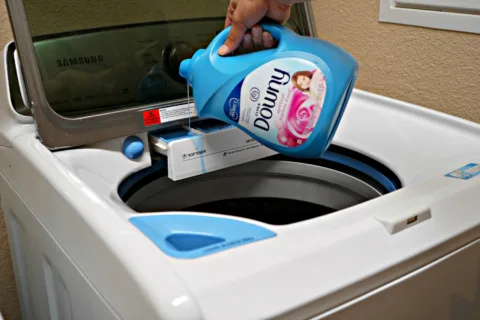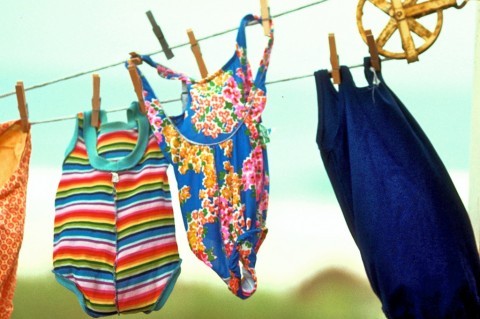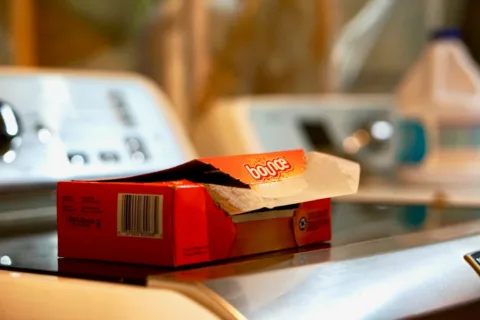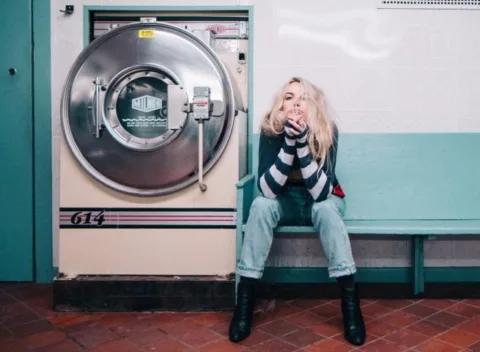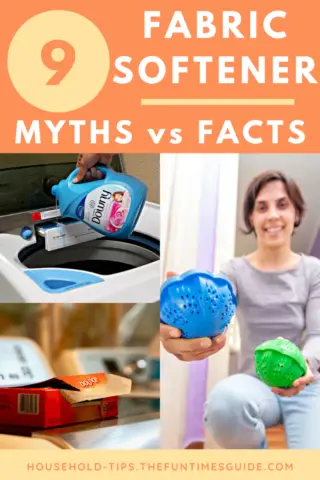There are all sorts of bold statements — both for and against — using liquid fabric softeners and dryer sheets these days.
Of course, those who advocate living a more environmentally friendly lifestyle typically avoid using fabric softeners and dryer sheets altogether. Or, they may choose to use only those that are made from all-natural products — like these natural fabric softeners and natural dryer sheets
that are available in stores.
Besides the eco-friendly reasons to stop using fabric softeners and dryer sheets, there are also a number of misconceptions about these 2 popular laundry aids.
The fact is: fabric softeners and dryer sheets do indeed make your clothes feel softer and smell better. And they reduce wrinkles too — especially when you air dry your clothes.
So, if you’re like most Americans, you’ve probably been using them for years without thinking twice. At this point, you may even find it difficult to live without them. (I know I do.)
If you’ve recently heard some warnings about the downsides of using fabric softener or dryer sheets, then it’s time to sort out the facts from the myths.
Following are some of the most common warnings about the use of fabric softeners and dryer sheets, combined with the lesser known facts — so you can make your own decision about whether you want to continue using a fabric softener or not.
#1 – Fabric softeners and dryer sheets lessen the life of your clothes dryer.
This isn’t entirely true.
It’s only true to the same extent that simply using your dryer lessens the life of your clothes dryer. That’s right, time itself is your dryer’s biggest enemy — not the fabric softener you use.
Due to its mechanical nature, dryer parts simply become worn out and eventually break down over time. This happens faster than the time that would be needed for you to notice the effects of longterm use of fabric softener on your dryer. Any residue that might accrue from liquid softener or dryer sheets can simply be removed with a brush or soap & water — without causing any damage to your dryer.
As for buildup from fabric softeners or dryer sheets burning out the heating element in your dryer and/or causing dryer fire, there’s just no validity to this.
The takeaways:
- Don’t skip times between cleaning out the lint trap on your clothes dryer. Even if there’s just a little bit of lint, it should be removed every single time between use.
- You don’t need to use more than one-half of a dryer sheet per load in order to avoid static cling, soften your clothes, and keep them smelling fresh.
- If you happen to notice a build-up of residue starting to form on the dryer’s lint screen, use a dryer brush to remove it or wash the lint screen using dishwashing liquid. (Allow to dry completely before putting it back into your dryer.)
#2 – Liquid fabric softeners and dryer sheets should not be used on towels.
This is somewhat true.
Fabric softener will definitely make towels softer… and fluffier.
Unfortunately, it will also reduce the absorbency of your towels — this will become more noticeable over time as you continue to use a liquid softener on towels.
Fabric softener residue on your towels also traps odors inside the fibers, giving them a mildew-like smell.
Your best bet is to only use fabric softeners and dryer sheets on towels occasionally, rather than with every single washing.
The takeaways:
- If you want soft and fluffy towels, you can add a 1/2 cup of vinegar to your washing machine during the wash cycle. Or, wash your towels a second time using 1 cup of vinegar instead of using laundry soap.
- To eliminate wet musty towel odors, be sure to get your wet towels into the dryer quickly. (Bacteria grows within 1 to 2 hours when towels are left sitting inside a damp washing machine!)
#3 – Fabric softeners and dryer sheets shouldn’t be used with microfiber towels.
This is true.
Liquid fabric softeners, as well as dryer sheets, will significantly damage the delicate fibers in microfiber.
In fact, few people realize that microfiber towels should not be subjected to heat at all.
So… not only are dryer sheets a problem — but the heat itself can wreak havoc on your microfiber towels. If you must dry them quickly, then choose a low-heat or no-heat option in the dryer.
Take it from me, if you happen to use fabric softener or dryer sheets with your microfiber towels, you will be left with regular ‘ol towels (or rags!) rather than the super-absorbent microfiber ones you started with. Most of the unique microfiber properties will be lost — and you cannot restore them once they’re gone. I know because I’ve done it… more than once. (Others have tried to restore the microfiber properties with mixed results.)
Therefore, even though it can be difficult to remember to wash and dry your microfiber towels separately from your other towels (if you tend to use a liquid softener with the rest of your laundry), it’s imperative that you do! Some even recommend washing your microfiber towels separately from your cotton towels — though I’ll admit I don’t always do that. Perhaps the super-absorbent properties in my microfiber towels would be even better if I did though.
The takeaways:
- Never use a liquid fabric softener when washing microfiber towels.
- Always make a point to air dry all of your microfiber towels — or simply tumble dry on low- or no-heat without using dryer sheets.
- Don’t use bleach with your microfiber towels either — it damages the delicate fibers that give microfiber its super-absorbing properties.
- Occasionally, to revive the properties of the microfiber, boil microfiber towels for 10 minutes. (Adding a bit of vinegar to the water can also be beneficial.)
#4 – Fabric softener and dryer sheets shouldn’t be used with athletic sportswear, spandex & nylon garments.
This is true.
Fabric softener can reduce the ability of certain fabrics to manage moisture and breathe — including sportswear, swimsuits, shapewear, undergarments, and athletic gear with wicking properties intended to keep you dry and cool.
The waxy softening agents in fabric softeners interfere with the garment’s ability to wick away moisture to keep you cool & dry (which is probably what you bought the garment for in the first place) — so you should avoid using softeners with most sportswear.
A word to the wise…
More and more clothing manufacturers are incorporating spandex (or elastane) into garments these days. It’s what gives your clothes some “stretch” (like leggings and jeans) and “control” (like shapewear and undergarments). So don’t think that because an item isn’t considered “athletic wear” that you’re in the clear.
Think beyond the “sports & outdoor” label when you’re deciding which of your garments can be rinsed with fabric softener and which ones cannot.
Bras and underwear also have stretchy components (typically consisting of nylon or spandex) that are likely to be weakened by the use of fabric softener.
The takeaways:
- If a garment has spandex in it, don’t use fabric softener.
- If a garment has nylon in it, don’t use fabric softener.
- Don’t use fabric softener on sportswear that has wicking properties to keep you cool and dry.
- Spandex, nylon, and items with elastic waistbands should not be put in the dryer either — because you’ll significantly reduce their lifespan. (Think underwear!)
#5 – Liquid fabric softeners (and some dryer sheets) can stain your clothes.
This is true.
That’s why most liquid softeners state right on the bottle that you shouldn’t pour it directly on your clothes.
The fact is: when liquid fabric softener is used on certain fabrics (or fabric blends), oily looking spots or discoloration can result. The stain looks blue-gray and greasy.
While the risk of stains occurring is relatively small, it’s still a possibility.
The takeaways:
- To avoid the possibility of fabric softener landing directly on your clothes and staining them in the washing machine, don’t overfill the machine with too many items. Doing so makes it difficult for enough water to circulate around the clothes and disperse the detergent and fabric softener equally.
- Here’s how to remove a fabric softener stain from your clothing (including stains from dryer sheets).
- Here’s how to remove fabric softener stains on specific fabrics and surfaces.
#6 – Fabric softeners and dryer sheets can exacerbate — or even cause — body acne.
There appears to be some truth to this one.
While there is no scientific proof to validate this claim, a number of people have experienced body acne as a result of using fabric softener. Even some doctors have experienced body acne after using fabric softener on their clothes.
The waxy softening agent in liquid fabric softener effectively clogs your pores.
It appears to only be a problem with those that are super-sensitive.
Dermatologists pointed out that results are likely to differ from person to person. Joshua Zeichner, MD, a New York dermatologist recommends patients with especially sensitive skin avoid the common laundry item. “Generally speaking, worsening of acne is not a problem I see from dryer sheets. Theoretically, however, the surfactants used in the sheets could irritate the skin in some sensitive-skinned acne patients leading to flares.” [Furthermore…] There are waxed on the sheets hat can rub off on clothing but it is not enough to clog pores. Liquid fabric softeners however do have more waxes that are left on sheets/clothing which may be more of a culprit.” Source
The takeaways:
- Since many laundry detergents already have fabric softener in them these days, adding additional fabric softener to your wash load (thus coating your clothing in it even more) could irritate your skin.
- If you have sensitive skin or you’re already battling acne, you should skip fabric softeners and dryer sheets altogether.
#7 – Bounce dryer sheets repel mice.
This one is false.
While certain smells will indeed annoy mice for a very short time, odoriferous things alone won’t keep them away.
That means the Bounce dryer sheets might work for a day or two — but then you’re just likely to have chewed up dryer sheets!
Mice are attracted to places where light comes through. Period. That’s where they’re looking for food or a place to nest. Block holes and spaces that let light in, and you’ll be rid of your mice problem.
The takeaways:
- Scent-based mice repellents aren’t the best course of action to rid yourself of a mouse problem.
- Even if the Bounce dryer sheets work for a short time, they won’t work for long.
#8 – Fabric softeners and dryer sheets should not be used with flame-retardant fabrics (like children’s clothing).
This is true.
The ingredients in liquid fabric softeners and dryer sheets apply a thin, waxy coating to all fabrics — thereby reducing the flame resistance of fabrics which have been treated with a flame retardant.
This includes items like children’s pajamas, baby clothing, and Halloween costumes.
My dad is a firefighter and I went to fire school while trying to join the fire department. If you read the labels on clothing and on the dryer sheets/dryer balls, it says NOT to use them on children’s or baby’s clothing. It degrades the flame retardant that is layered in the clothing. (provided it’s not organic). Even the dryer balls say not to use them on baby clothing. Source
The takeaways:
- The truth is fabric softener and dryer sheets aren’t necessary items that you must have in your arsenal of laundry cleaning products. They’re merely a convenience.
- Be sure to read the label whenever you buy a new item of clothing. You might be surprised how many times it says “Do Not Use Softeners!”
- Dryer sheets themselves are not flammable, but they significantly reduce the flame retardant features that are built into items (like children’s clothing).
#9 – Liquid fabric softener softens hard water (if you don’t have a water softener in your home).
This is false.
When you have hard water, you need to add a water softener product to your laundry — not a fabric softener.
The best (and most popular) ones are Calgon (liquid), Borax (powder), or Charlie’s Soap & Hard Water Treatment (powder).
If you want to reap the rewards of using fabric softener when you have hard water, you can. You will just need to use more than someone with soft water would use — to get the same effects.
The takeaways:
- When you have hard water, using a hard water treatment or laundry booster is important — more important than using a fabric softener.
- With hard water, you have to use more detergent… and more fabric softener — if its effects are important to you.
The Bottom Line…
- Is fabric softener necessary? No. It makes your clothing smell good and feel softer, but that has nothing to do with making your clothes cleaner.
- Are dryer sheets necessary? No. They make your clothes smell good and reduce static cling, but wool dryer balls will reduce static cling and speed up drying time, as well. (And if you add a couple drops of essential oil when drying on a low- or no-heat setting, you’ll get great smelling clothes, too.)
- Does fabric softener work? Yes. It makes the garment feel softer to the touch — especially rougher materials like true denim and 100% cotton.
- Is fabric softener bad? No. But it’s all relative… and depends on your personal convictions in life.
- Is fabric softener bad for clothes? Yes, but only some materials. It will definitely impact the durability and effectiveness of certain fibers more than others — especially elastic, nylon, spandex, microfiber, garments with “wicking properties” built in, and fire-retardant items. In addition, it can leave a stain if poured directly on clothing.
- Is fabric softener bad for you? No, not technically. But it depends on your personal preferences and your own perspective on environmental matters.
- Are dryer sheets bad for your dryer? No. It doesn’t increase the likelihood of a dryer fire. And if you happen to notice any softener buildup on the lint screen, it washes off easily.
- Are dryer sheets flammable? No. The sheets themselves are not flammable. The confusion on this comes from the fact that dryer sheets will make flame retardant children’s garments more flammable than those not dried with dryer sheets.
- Should you use fabric softener on towels? No. It reduces the amount of water they can absorb.
- Can you use fabric softener on microfiber towels? No. It will affect the towels’ ability to absorb water.
- Do dryer sheets keep mice away? No. Mice are only temporarily repelled by strong odors — such as those found on Bounce dryer sheets.
- Can fabric softener cause acne? Yes, but only for those with extra-sensitive skin. Anyone with overly sensitive skin should refrain from using towels and wearing clothes that have been laundered with fabric softener.
- Does fabric softener make the water softer when you have hard water? No. the only way to achieve softer water that is less harsh on clothing is to use a water softener product… or buy a standalone water softener.
In the end, everyone has to make up their own mind regarding the use of dryer sheets and fabric softener.
As we move toward a more eco-friendly world, environmentally-friendly alternatives are definitely becoming more and more popular.
Here’s how to make your own all-natural fabric softener and remove static cling.
And here’s my experience using chemical-free laundry balls instead of traditional laundry detergent.
If you found this post helpful, it would mean the world to me if you would share with others on Pinterest:

